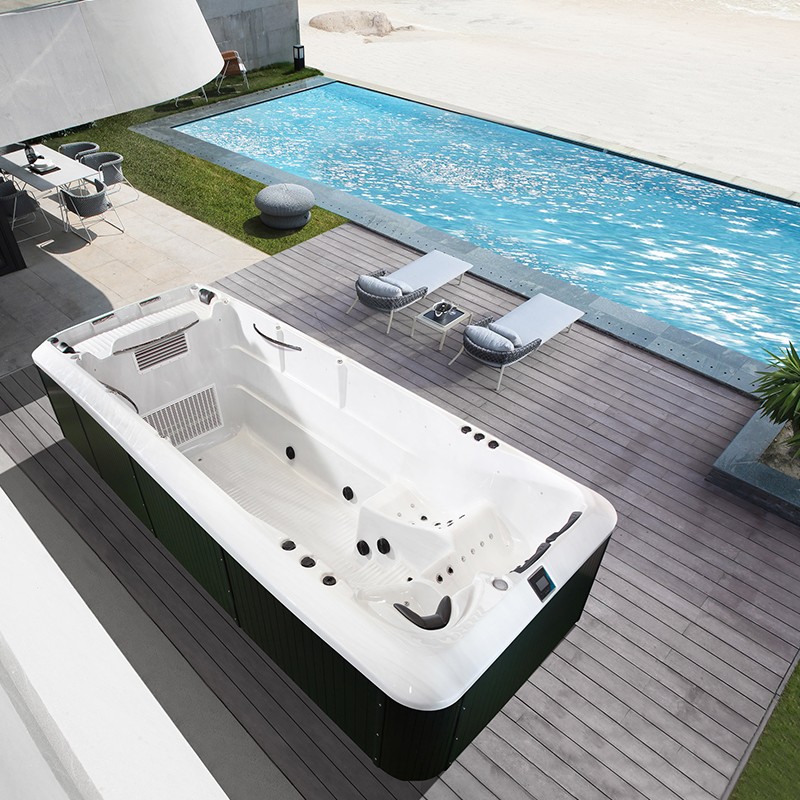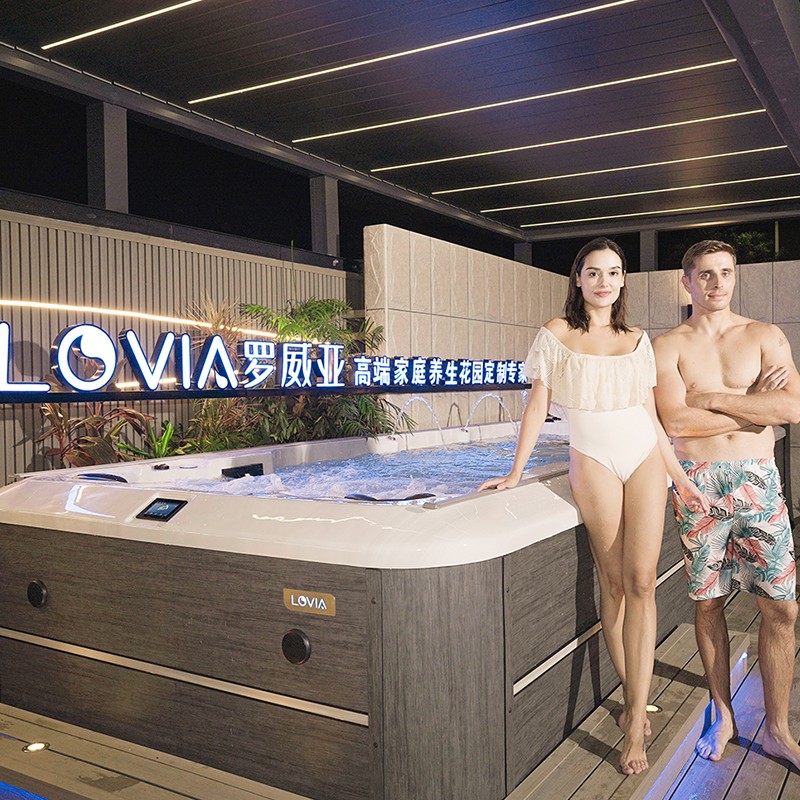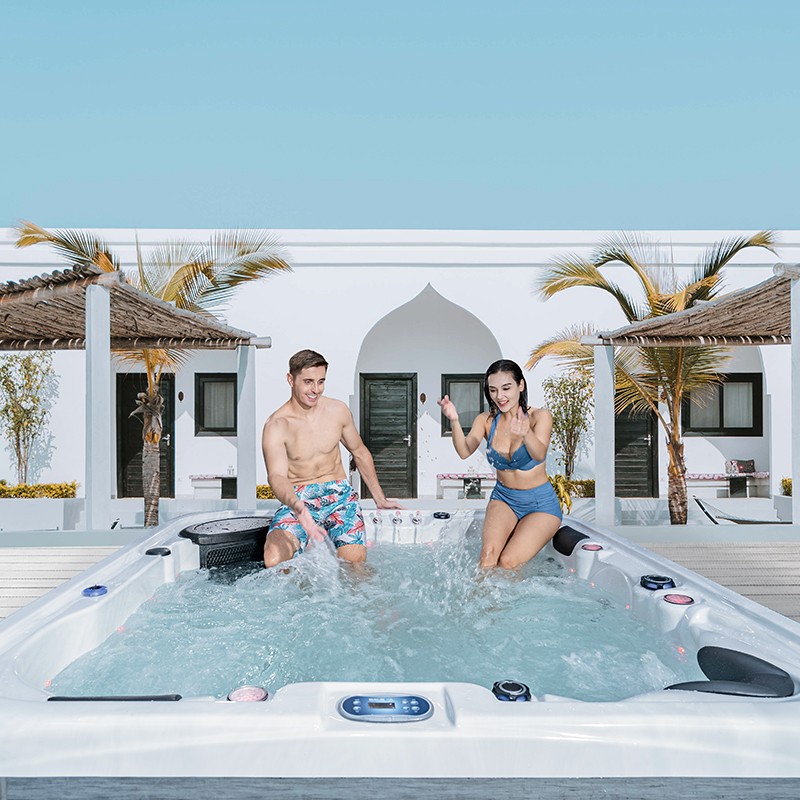
Do Swim Spa Hot Tubs Need Regular Heating When Not in Use?
2025-11-11 15:30In modern family leisure and wellness concepts, swim spa hot tubs have become increasingly popular high-end health devices.
They satisfy daily needs for aquatic exercise and relaxation, allowing users to enjoy the comfort of a spa experience at home.
However, a common question arises when people are not using the tub:
"Does the swim spa hot tub need regular heating when not in use?"
This seemingly simple question actually involves several professional aspects, including energy management, water quality maintenance, equipment protection, and lifespan.
This article will systematically analyze whether swim spa hot tubs need regular heating when not in use, why (or not), and how to scientifically control temperature and energy consumption, from a technical and usage perspective, so that you can make more informed decisions in actual use.

Why does the question "Does the swim spa hot tub need regular heating?" arise?
Many users, after purchasing a swim spa hot tub, often only use it once or twice a week, or even for extended periods during winter or when traveling.
At this point, the water remains in the tank, and the equipment is in standby mode. People then begin to consider:
• Should the water be continuously heated to maintain the temperature if the equipment is not used for an extended period?
• Will stopping heating affect water quality or the equipment?
• Can periodic heating prevent bacterial growth?
• Does continuous heating waste energy?
These questions are all closely related to the heating system, circulation filtration system, and water quality management.
Understanding these core principles is a prerequisite for determining whether periodic heating is necessary.
How does the heating system of a swim spa hot tub work?
The heating system of a swim spa hot tub typically consists of the following components:
• Heater: Responsible for maintaining the water temperature within a set range (generally between 26°C and 40°C).
• Thermostat: Automatically detects and adjusts the water temperature to prevent overheating or undercooling.
• Circulation Pump System: Keeps the water flowing continuously, preventing water sedimentation or localized temperature differences.
• Filter System: Continuously filters impurities and works with disinfectants to keep the water clean.
When the heating system is running, the water temperature is maintained stably, but this also means continuous energy consumption.
Continuing to heat water without use for extended periods will increase electricity bills; conversely, completely shutting off the heating system may cause water quality deterioration or equipment aging due to moisture.
What problems will occur if the swim spa hot tub is not heated regularly?
1. Drop in water temperature leading to bacterial growth
When the water temperature drops to room temperature (below 20°C), some bacteria and mold can easily multiply in the humid environment.
Especially if sufficient disinfectant is not added, the circulating water in the swim spa hot tub may begin to deteriorate within a few days.
2. Moisture and scale buildup in the pump and pipes
If the water is not heated or circulated for a long time, scale, limescale deposits, and even biofilm will form in the internal pipes.
These deposits not only affect water flow but may also clog nozzles and the pump system.
3. Accelerated Aging of Heaters and Sensors
A damp and cold environment can cause condensation on the heating element and sensor surface. Prolonged exposure to this condition can lead to oxidation and shorten their lifespan.
4. Structural Stress Due to Water Temperature Fluctuations
Frequent temperature changes can cause thermal expansion and contraction of the acrylic inner tank or piping materials of the swim spa hot tub, increasing the risk of leakage.
5. Energy Imbalance and Increased Start-up Load
Completely shutting off heating requires a longer time to heat the water to the set temperature before reuse, resulting in energy waste.
Therefore, from a maintenance perspective, while "completely not heating" is energy-efficient, it is not conducive to long-term operation.

Should the swim spa hot tub be kept heated when not in use?
The answer is: continuous heating is not necessary, but periodic short-term heating is recommended.
When the swim spa hot tub is not used for extended periods, "periodic heating" is more scientifically sound than "continuous heating."
This method maintains water activity while avoiding energy waste.
Recommended practices are as follows:
1. Heat 1-2 times per week
Raise the water temperature in the swim spa hot tub to approximately 35°C and keep it circulating for 1-2 hours to effectively inhibit bacterial growth.
2. Simultaneously start the circulation system
When heating, be sure to turn on both the water circulation and filtration systems simultaneously to ensure even heat distribution and reduce scale buildup inside the pipes.
3. Rechlorinate or replace part of the water after use
After heating, add an appropriate amount of disinfectant to keep the water clean and prevent microbial growth.
4. Adjust heating frequency according to the season
In summer, heat once every two weeks; in winter, it is recommended to heat once a week to avoid excessively low water temperatures that could cause pipes to freeze or damage the equipment.
Why is "regular heating" more reasonable than "no heating at all"?
1. Maintain stable water quality
Regularly raising the temperature keeps the water circulating actively, reducing the rate of algae and bacterial growth.
2. Avoid prolonged system stagnation
If the circulation pump and jet pipes of the swim spa hot tub are not used for extended periods, problems such as cracked seals and lubrication failure can easily occur.
3. Prevents Condensation and Moisture Corrosion
Short-term heating keeps the interior dry, reducing condensation and preventing electrical components from getting damp.
4. Extends Heater Life
Periodic operation prevents scaling or oxidation of the heating element due to prolonged inactivity.
5. Saves Start-up Energy
Maintaining periodic heating avoids the need for significant energy to heat cold water each time you restart, resulting in overall energy savings.

What is the correct maintenance method for a swim spa hot tub when not in use for an extended period?
If you plan to not use it for a long time (e.g., more than a month), in addition to periodic heating, systematic maintenance should be performed.
1. Thorough Cleaning and Draining
If you are certain that it will not be used for more than one month, it is recommended to drain the water and dry the tub surface, and clean the filter and nozzles.
2. Activate the Drying Circulation Mode
Some swim spa hot tubs are equipped with a drying circulation or air-drying function, which maintains internal ventilation after draining.
3. Regularly Check the Heater and Water Pump
Even when not heating, the heating and circulation system should be run monthly to ensure all components are functioning properly.
4. Cover with an insulated cover
Using a thick, waterproof insulated cover can reduce dust ingress and maintain a stable temperature.
5. Keep the power on standby
Do not completely disconnect the power so that the system can perform automatic detection and antifreeze protection.
Is the anti-freeze mode of a swim spa hot tub the same as "periodic heating"?
Many modern swim spa hot tubs have a built-in anti-freeze mode.
This mode automatically activates the heating and circulation system when the water temperature drops to a set value (usually 5°C–10°C) to prevent the pipes from freezing.
However, note that the purpose of the anti-freeze mode is only to prevent freezing, not to maintain water quality or equipment hygiene.
Therefore, even with an anti-freeze function, it is still recommended that users perform periodic heating and circulation when the tub is not in use for extended periods to maintain water quality and system stability.
Does periodic heating waste a lot of electricity?
From an energy consumption perspective, periodic heating is much more energy-efficient than continuous heating.
For example, a standard swim spa hot tub (approximately 6 cubic meters of water) consumes 50-80 kWh of electricity per week if maintained at a constant temperature of 38°C.
However, by heating 1-2 times per week for 1 hour each time, total power consumption can be reduced by more than 60%.
Furthermore, installing a high-efficiency insulation cover and side panel insulation layer will significantly reduce heat loss.
Therefore, properly controlling the heating cycle can save energy and ensure the healthy operation of the equipment.
When is periodic heating unnecessary?
While periodic heating is generally recommended, it is not necessary to heat in the following specific situations:
• The water has been drained and the equipment is completely dry;
• The ambient temperature is consistently above 10°C and the air is dry;
• The equipment is stored for an extended period without power (requiring professional protective measures);
• When planning to replace the entire tank of water before reuse.
Under these conditions, there will be no freezing or dampness issues inside the equipment, and it is safe to stop using it.

How to set the heating cycle of a swim spa hot tub more scientifically?
To balance energy efficiency and maintenance, please refer to the following suggestions:
Frequency of Use | Recommended Heating Cycle | Temperature range | Cycle Time |
| Daily Use | Constant Temperature Mode | 36–38°C | Automatic Cycle |
| Use 1–2 times per week | Heat once a week | 34–36°C | 1–2 hours |
| Occasional Use | Heat once every two weeks | 30–35°C | 1 hour |
| Long-term Discontinuation | Heat once a month or drain water | Around 30°C | 30 minutes |
This scientific cycle management model effectively balances water quality maintenance, energy consumption, and equipment lifespan.
What details should be noted when heating periodically?
• Turn on filter circulation: Heating without circulation results in uneven temperature distribution and is prone to scaling.
• Check the sensitivity of the temperature control system: Prevent overheating or heater idling.
• Keep the lid closed: Prevent heat loss and reduce dust.
• Test water quality after heating: Confirm that the pH and chlorine concentration are within the normal range.
• Avoid frequent heating and cooling: Excessive temperature differences will accelerate equipment aging.
Does the swim spa hot tub need to be heated periodically when not in use?
In summary:
When not in use, the swim spa hot tub does not need continuous heating, but it should be heated and circulated periodically for short periods to maintain water quality and equipment stability.
This not only helps prevent bacterial growth and system aging but also reduces energy consumption when restarting.
The correct procedure is as follows:
• Heat once a week or every two weeks;
• Simultaneously activate the circulation system;
• Maintain the temperature between 30–36°C;
• Keep the insulation cover closed to save energy.
Through scientific maintenance and periodic management, the swim spa hot tub maintains optimal condition whether in use or idle, providing you with a consistently comfortable and safe user experience.
What Payment Terms Does LOVIA SPA Offer?
Our standard payment terms are T/T — 30% deposit and 70% balance before shipment. This secure system is designed for both new and returning customers worldwide. Buyers can request proforma invoices and factory quotes before making payments. With over 35 years of export experience, LOVIA SPA guarantees clear sales terms, reliable lead times (within 30 days after deposit), and continuous order tracking.
